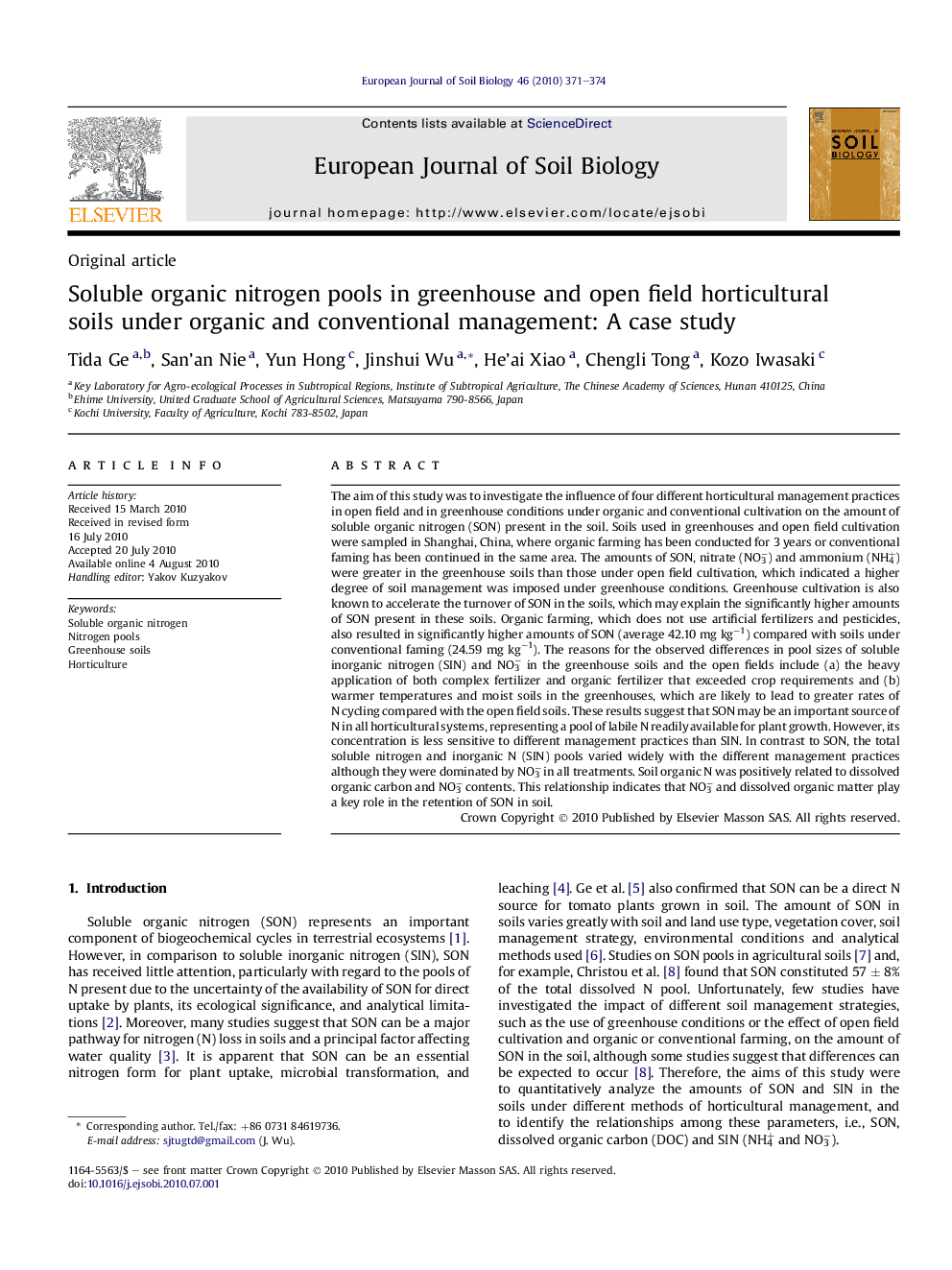| کد مقاله | کد نشریه | سال انتشار | مقاله انگلیسی | نسخه تمام متن |
|---|---|---|---|---|
| 4392218 | 1618151 | 2010 | 4 صفحه PDF | دانلود رایگان |

The aim of this study was to investigate the influence of four different horticultural management practices in open field and in greenhouse conditions under organic and conventional cultivation on the amount of soluble organic nitrogen (SON) present in the soil. Soils used in greenhouses and open field cultivation were sampled in Shanghai, China, where organic farming has been conducted for 3 years or conventional faming has been continued in the same area. The amounts of SON, nitrate (NO3−) and ammonium (NH4+) were greater in the greenhouse soils than those under open field cultivation, which indicated a higher degree of soil management was imposed under greenhouse conditions. Greenhouse cultivation is also known to accelerate the turnover of SON in the soils, which may explain the significantly higher amounts of SON present in these soils. Organic farming, which does not use artificial fertilizers and pesticides, also resulted in significantly higher amounts of SON (average 42.10 mg kg−1) compared with soils under conventional faming (24.59 mg kg−1). The reasons for the observed differences in pool sizes of soluble inorganic nitrogen (SIN) and NO3− in the greenhouse soils and the open fields include (a) the heavy application of both complex fertilizer and organic fertilizer that exceeded crop requirements and (b) warmer temperatures and moist soils in the greenhouses, which are likely to lead to greater rates of N cycling compared with the open field soils. These results suggest that SON may be an important source of N in all horticultural systems, representing a pool of labile N readily available for plant growth. However, its concentration is less sensitive to different management practices than SIN. In contrast to SON, the total soluble nitrogen and inorganic N (SIN) pools varied widely with the different management practices although they were dominated by NO3− in all treatments. Soil organic N was positively related to dissolved organic carbon and NO3− contents. This relationship indicates that NO3− and dissolved organic matter play a key role in the retention of SON in soil.
Research highlights
► The amounts of SON, nitrate (NO3−) and ammonium (NH4+) were greater in the greenhouse soils than those under open field cultivation, which indicated a higher degree of soil management was imposed under greenhouse conditions.
► Greenhouse cultivation is also known to accelerate the turnover of SON in the soils, which may explain the significantly higher amounts of SON present in these soils.
► Organic farming, which does not use artificial fertilizers and pesticides, also resulted in significantly higher amounts of SON (average 42.10 mg kg−1) compared with soils under conventional faming (24.59 mg kg−1).
► The reasons for the observed differences in pool sizes of soluble inorganic nitrogen (SIN) and NO3− in the greenhouse soils and the open fields include (a) the heavy application of both complex fertilizer and organic fertilizer that exceeded crop requirements and (b) warmer temperatures and moist soils in the greenhouses, which are likely to lead to greater rates of N cycling compared with the open field soils.
► These results suggest that SON may be an important source of N in all horticultural systems, representing a pool of labile N readily available for plant growth.
► However, its concentration is less sensitive to different management practices than SIN.
► In contrast to SON, the total soluble nitrogen and inorganic N (SIN) pools varied widely with the different management practices although they were dominated by NO3− in all treatments.
► Soil organic N was positively related to dissolved organic carbon and NO3− contents.
► This relationship indicates that NO3− and dissolved organic matter play a key role in the retention of SON in soil.
Journal: European Journal of Soil Biology - Volume 46, Issue 6, November–December 2010, Pages 371–374